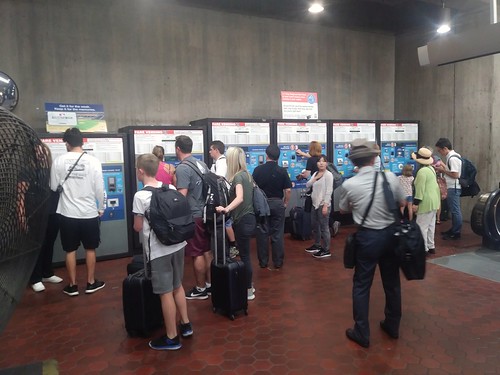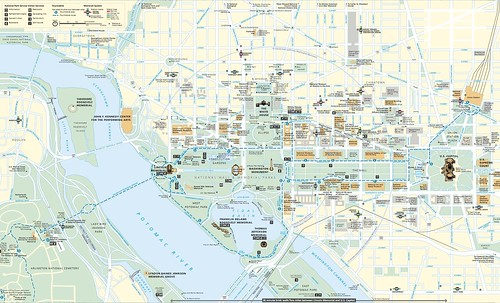World Tourism Day: In terms of providing great visitor services, is DC being a highly visited tourism destination a good or a bad thing?
=====
This partially written piece had been up briefly. It's now complete with a new publishing date (Wednesday instead of Monday).
=====
World Tourism Day is Thursday September 27th.
====
Last month, the Washington Business Journal reported ("D.C. gets international boost, breaks tourism record for eighth year in a row on 2017 tourism statistics. From the article:
The District of Columbia saw an uptick in overseas visitors in 2017, helping it break its eighth straight overall tourism record.
About 2 million overseas visitors — those from countries other than Canada and Mexico — came to D.C. last year, a 2.5 percent increase from 2016, when the number fell 1.7 percent.
D.C. welcomed 22.8 million visitors overall when domestic tourism is included, a 3.6 percent increase from the previous year. Those visitors spent $7.5 billion in the District in 2017.
Destination D.C., the city’s tourism marketing organization, released the numbers Tuesday using international visitor data from the U.S. Department of Commerce and its own survey of international travelers.
 Family Circus cartoon, 8/14/2008.
Family Circus cartoon, 8/14/2008.I do lean towards the latter out of the belief that being highly visited breeds a sense of complacency, that the city takes the lesson that it must be doing a great job in terms of visitor services and hospitality, otherwise we wouldn't be so highly visited.
It's not just that the city:
(1) doesn't have a real visitor center or set of visitor centers, including Union Station, the city's most highly visited destination
(2) doesn't have a system for supporting sub-city tourism in places like Georgetown, Capitol Hill, and Dupont Circle
(3) is parsimonious in providing tourism literature to area visitor centers in Virginia and Maryland
(4) needs to update its wayfinding system and federal entities like the US Capitol and the National Park Service have separate systems
(5) makes it hard for visitors to make sense of the transit system
(6) hasn't worked with other entities to create adequate regional tourism centers at the airports.
It's further complicated by the fact that the federal government visitor centers are disjoint and refuse to distribute non-federal information, e.g., local tourism materials and maps, and sometimes fail to distribute information from other federal governments.
It would probably help if the National Park Service, which has park installations and historic sites throughout the region--DC, Maryland, Virginia, West Virginia, and Pennsylvania--should consider developing not only a master set of integrated brochures, but also a set of "master visitor centers" organized on a regional basis and treating all of the park units as an integrated system, to provide information beyond those of any specific park installation.

People buying farecards at Union Station.
The Federal Government's Comprehensive Plan for DC does address visitor services in the Visitor and Commemoration Element. The plan recommendations do address some of my concerns (not sure if previous comments on NCPC planning processes have had some impact on this):
VC.B.1 Support the dissemination of information at regional locations frequented by visitors (e.g., hotels, restaurants, Metrorail stations, and major transportation centers). Information should include federal and local visitor attractions, events, tours, stores, shops, and restaurants nearby.The challenge is to push these recommendations into actual practice.
VC.B.4 Explore the feasibility of creating a central visitor information center and/or multi-media platform that includes information about both public and private visitor attractions.
VC.B.5 Develop information visitor centers, kiosks, exhibits, and other educational programming in public areas of government facilities and
other appropriate locations in the National Capital Region to inspire and educate visitors about the role of government and national attractions
VC.B.7 Support the location of information kiosks and visitor centers at federal facilities throughout the National Capital Region.
VC.B.8 Enhance visual and functional connections to visitor attractions through well-designed and coordinated signage, pathways, parkways,
streetscaping, wayfinding tools, and programming.
DC's Comprehensive Plan does not have a visitor element, nor do we have a Tourism Development and Management Plan. Although it has problems, Charleston's Tourism Management Plan is a model.
Past writings of particular relevance
-- "A National Mall-focused heritage (replica) streetcar service to serve visitors is a way bigger idea than a parking garage under the Mall," 2013
-- "Need for a comprehensive visitor transportation plan in DC," 2011
-- "Parking under the National Mall should be part of an integrated approach to visitor services and management," 2013
This entry makes these recommendations:
• an infill Yellow Line subway station to serve the west edge of the Mall, specifically the Jefferson Memorial (although the station would have to be on the Long Bridge side, which is east of the Memorial
• a visitor center located at the proposed Jefferson Memorial Station
• a primary visitor center for the city at Union Station
• promoting parking to tourists at Union Station
• running a bus service on the National Mall between the visitor centers and the various destinations, with the main staging sites being Union Station and the Jefferson Memorial subway station
• developing service corridors under the National Mall as part of the parking structure so that waste removal and other services for the National Mall can be delivered underground.
-- "New DC Circulator route serving National Mall reminds us that we are neglecting connections from west to east and fail to adequately connect Georgetown to the National Mall," 2015
This piece makes the point that a proposed heritage streetcar transportation system for "the National Mall" should include service to Arlington Memorial Cemetery and the Iwo Jima Memorial. The NPS brochure map "The National Mall and Smithsonian Museums" treats the National Mall as spanning DC and Arlington County.

-- "DC State Rail Planning Initiative," 2015, has extensive discussion about tourism development elements of Union Station, including serving as a staging point for railfan tourism, having a tourism center, creating a small tourism-transportation museum within the expanded program for the station, etc.
National Park Service Visitor Transportation Study
-- Visitor Transportation Study for the National Mall and Surrounding Park Areas
Labels: cultural heritage/tourism, economic development planning, tourism, tourism marketing, tourism planning, visitor services



0 Comments:
Post a Comment
<< Home